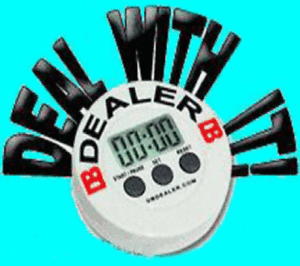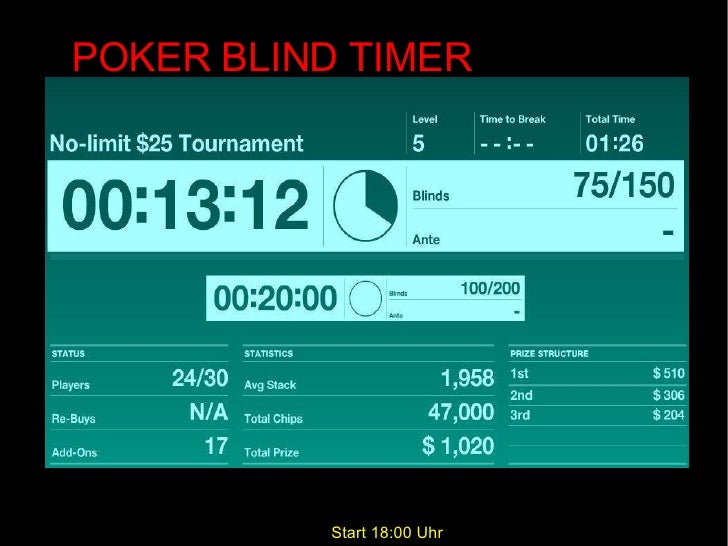Poker Blind Uhr

- Poker Blinds Are Up
- Poker Blind Uhrichsville
- Poker Blind Timer Free Download
- Blind Uhr Poker Download
- Poker Blind Timer App
Poker Blinds Are Up


This free blind clock will keep track of your poker rounds when you play poker with friends. Easily setup the poker rounds, round time, poker blind values and ante in your custom setup. Or play with an easy default poker setup. Custimize this Texas Holdem Poker Blinds Timer the way you like to use it, for example: - Poker Ante - A default time.
In button games, a non-playing dealer normally does the actual dealing. A round disk called the button is used to indicate which player has the dealer position.
- Travis Poker Timer is a stand alone program that runs on your OS X or Windows computer. It manages your tournament game, organising players, calculating blinds, chips and prizes. Travis Poker Director is a poker league management system that integrates directly with the poker timer.
- A Poker Blinds Level Timer application. This application can be used at home poker games to keep players informed of the current blind level (small.
- In order to start betting in Hold’em, forced bets (known as blinds) are made by the two players immediately clockwise from the dealer button.The person immediately clockwise from the dealer has the small blind, and the next player clockwise has the big blind. Making blind bets is known as posting and this is done before any cards are dealt.
- The blinds are forced bets posted by players to the left of the dealer button in flop-style poker games. The number of blinds is usually two, but it can range from none to three. The small blind is placed by the player to the left of the dealer button and the big blind is then posted by the next player to the left. The one exception is when there are only two players (a 'heads-up' game), when.
The player with the button is last to receive cards on the initial deal and has the right of last action after the first betting round. The button moves clockwise after a deal ends to rotate the advantage of last action.
One or more blind bets are usually used to stimulate action and initiate play. Blinds are posted before the players look at their cards. Blinds are part of a player's bet, unless the structure of a game or the situation requires part or all of a particular blind to be 'dead.'
Dead chips are not part of a player's bet. With two blinds, the small blind is posted by the player immediately clockwise from the button, and the big blind is posted by the player two positions clockwise from the button. With more than two blinds, the little blind is normally left of the button (not on it).
Poker Blind Uhrichsville
Action is initiated on the first betting round by the first player to the left of the blinds. On all subsequent betting rounds, the action begins with the first active player to the left of the button.
Rules for Using Blinds in Poker
1. Each round every player must get an opportunity for the button, and meet the total amount of the blind obligations. Either of the following methods of button and blind placement may be designated to do this:
(a) Moving button - The button always moves forward to the next player and the blinds adjust accordingly. There may be more than one big blind.
(b) Dead button - The big blind is posted by the player due for it, and the small blind and button are positioned accordingly, even if this means the small blind or the button is placed in front of an empty seat, giving the same player the privilege of last action on consecutive hands.
[See 'Section 16 - Explanations,' discussion #1, for more information on this rule.]
2. A player who posts a blind has the option of raising the pot at the first turn to act. (This does not apply when a 'dead blind' for the collection is used in a game and has been posted).
3. In heads-up play with two blinds, the small blind is on the button.
4. A new player entering the game has the following options:
(a) Wait for the big blind.
(b) Post an amount equal to the big blind and immediately be dealt a hand. (In lowball, a new player must either post an amount double the big blind or wait for the big blind.)
5. A new player who elects to let the button go by once without posting is not treated as a player in the game who has missed a blind, and needs to post only the big blind when entering the game.
6. A person playing over is considered a new player, and must post the amount of the big blind or wait for the big blind.
7. A new player cannot be dealt in between the big blind and the button. Blinds may not be made up between the big blind and the button. You must wait until the button passes. [See 'Section 16 - Explanations,' discussion #3, for more information on this rule.]
8. When you post the big blind, it serves as your opening bet. When it is your next turn to act, you have the option to raise.
9. A player who misses any or all blinds can resume play by either posting all the blinds missed or waiting for the big blind. If you choose to post the total amount of the blinds, an amount up to the size of the minimum opening bet is live. The remainder is taken by the dealer to the center of the pot and is not part of your bet. When it is your next turn to act, you have the option to raise.
10. If a player who owes a blind (as a result of a missed blind) is dealt in without posting, the hand is dead if the player looks at it before putting up the required chips, and has not yet acted. If the player acts on the hand and plays it, putting chips into the pot before the error is discovered, the hand is live, and the player is required to post on the next deal.
11. A player who goes all-in and loses is obligated to make up the blinds if they are missed before a rebuy is made. (The person is not treated as a new player when reentering.)
12. These rules about blinds apply to a newly started game:
(a) Any player who drew for the button is considered active in the game and is required to make up any missed blinds.
(b) A new player will not be required to post a blind until the button has made one complete revolution around the table, provided a blind has not yet passed that seat.
(c) A player may change seats without penalty, provided a blind has not yet passed the new seat.
13. In all multiple-blind games, a player who changes seats will be dealt in on the first available hand in the same relative position. Example: If you move two active positions away from the big blind, you must wait two hands before being dealt in again. If you move closer to the big blind, you can be dealt in without any penalty. If you do not wish to wait and have not yet missed a blind, then you can post an amount equal to the big blind and receive a hand. (Exception: At lowball you must kill the pot, wait for the same relative position, or wait for the big blind; see 'Section 11 - Lowball,' rule #7.)
14. A player who 'deals off' (by playing the button and then immediately getting up to change seats) can allow the blinds to pass the new seat one time and reenter the game behind the button without having to post a blind.
15. A live 'straddle bet' is not allowed at limit poker except in specified games.
Poker Blind Timer Free Download
In order to start betting in Hold’em, forced bets (known as blinds) are made by the two players immediately clockwise from the dealer button. The person immediately clockwise from the dealer has the small blind, and the next player clockwise has the big blind. Making blind bets is known as posting and this is done before any cards are dealt.
Blind Uhr Poker Download
The size of the bets are determined by the limits of the game that you’re playing and the small blind is nearly always half of the big blind. So a $2/$4 Limit Hold’em game has a small blind of $1 and a big blind of $2.
Blinds are forced bets. The players in these positions must make these bets or they aren’t dealt cards in the hand. These blinds, in turn, force betting action on the table after everyone has been dealt their hole cards.
Poker Blind Timer App
At a casino, when you first sit down at a Hold’em table, the rules vary as to whether you have to post blinds (even if you’re out of the normal blind positions for that hand) in order to be dealt a hand.
In Las Vegas, you’re dealt a hand as soon as you sit down and have shown that you meet the table’s minimum buy-in. You’re not required to post a blind in order to get hole cards. Conversely, in most California card rooms, you’re required to post a big blind in order to get your starting hand.
In cases where you’re required to post a big blind before you’re dealt cards, you’re mildly better off just waiting until it would normally be your turn to get the big blind anyway, rather than jumping straight into the hand. Waiting like this keeps you from making an extra forced bet and gives an added bonus of being able to case the players at the table while you aren’t actually playing. Dealers are used to this behavior and will probably ask you if you want to sit out (that is, wait until it’s your turn to post the big blind).
How soon you post is a fine point, though, that doesn’t really make that much difference. If you’re itchin’ to play, or if you have a very limited amount of time to play, go ahead and jump in. The dealer will tell you whether you’re required to post a big blind.